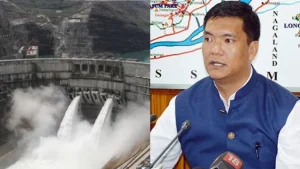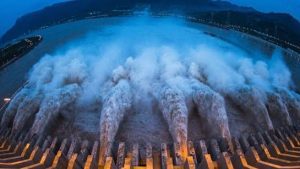A Looming Crisis: China’s Mega Dam and the “Water Bomb” Fear
As China advances with its colossal hydropower project on the Yarlung Tsangpo River, Indian leaders and experts are voicing serious concerns about the implications for Arunachal Pradesh and the wider Northeast region. Tensions have escalated with Arunachal MP Tapir Gao describing the project as a potential “water bomb,” one that could trigger ecological, humanitarian, and geopolitical disasters.
The controversial mega-dam—reportedly part of China’s long-term strategic plan—is being constructed near the “Great Bend” of the Yarlung Tsangpo, not far from the Indian border. This region marks the river’s dramatic U-turn into Arunachal Pradesh, where it becomes the Brahmaputra River.
Strategic and Environmental Risks of China’s Great Bend Dam
According to experts, the project poses a multitude of threats. If completed, the dam will be among the world’s largest hydropower stations, capable of altering the flow of one of Asia’s most vital rivers. This manipulation could impact millions downstream in India and Bangladesh.
China claims the project supports clean energy goals, but Indian experts argue it may serve dual purposes—energy and strategic dominance.
- Seismic Risks: The region lies in a high seismic zone. Massive constructions like this dam could increase the risk of landslides, earthquakes, and glacial lake outbursts.
- Flooding and Droughts: Arunachal leaders warn that China could control water flow, potentially releasing vast volumes during monsoon season (causing floods) or cutting off supply during dry months (leading to droughts).
- Agricultural Impact: Changes in the river’s flow can devastate agriculture in Assam and Arunachal, where millions rely on the Brahmaputra for irrigation and sustenance.
Tapir Gao Sounds the Alarm in Parliament
Tapir Gao, MP from Arunachal East, has been a vocal critic of the dam. He recently urged the Indian government to raise the issue at international platforms such as the United Nations and climate conferences.
“This dam is not just a hydropower station—it is a water bomb aimed at India. If China decides to weaponize water, it can flood Northeast India in hours,” said Gao in his address to Parliament.
He stressed the importance of diplomatic and strategic preparedness, suggesting the government must treat this not only as an environmental concern but as a national security threat.
Arunachal CM Weighs In: China’s Actions Can’t Be Ignored Anymore
Arunachal Pradesh Chief Minister Pema Khandu echoed Gao’s concerns, taking a strong stand against China’s dam construction and calling for unity at the national level.
“We cannot turn a blind eye to this imminent threat. This isn’t just about Arunachal—it’s about the integrity and safety of the entire Northeast and beyond. We are talking about a lifeline being choked at the source,” said CM Khandu during a press briefing.
He urged central authorities to deploy a comprehensive diplomatic strategy and accelerate India’s own infrastructure development along the border to counterbalance China’s moves.
Khandu also stressed the need for strong river monitoring systems, regional disaster preparedness, and joint action plans among Northeast states to mitigate potential damage.


Experts Warn: Potential for Eco-Disaster and Regional Instability
Hydrologists, defense analysts, and climate scientists gathered recently at a seminar in Guwahati to discuss the issue. They pointed to China’s history of using upstream control to exert pressure on downstream nations like India and Vietnam.
Dr. S.K. Singh, a leading hydrologist, stated:
“The dam’s height and capacity are reportedly unmatched in the region. This isn’t merely a dam—it’s a geostrategic lever. If China stores water during lean periods or suddenly releases it, the downstream impact could be devastating.”
Environmental Impact: The Brahmaputra basin is one of the most ecologically sensitive zones in Asia. Altering its flow could harm biodiversity, destroy wetlands, and displace indigenous communities.
Geopolitical Angle: Analysts also point out that this move by China could be aimed at asserting greater control over the region, especially as tensions rise over Arunachal Pradesh, which Beijing continues to claim as “South Tibet.”
India’s Response: Monitoring and Diplomatic Engagement
While India continues to monitor developments closely, experts believe a stronger diplomatic push is necessary. India and China share no formal water-sharing treaty, unlike China’s arrangements with other countries like Kazakhstan.
The Indian government has initiated satellite surveillance of the construction site, set up high-altitude monitoring stations, and intensified collaboration with Bhutan and Bangladesh to assess broader regional impacts.
Some reports suggest India is planning counter-dam measures on the Siang and Dibang rivers, along with improved hydrological data sharing and contingency plans in Assam and Arunachal.
Civil Society and Media Call for Transparency and Dialogue
Several NGOs and think tanks have called for increased public awareness about the dam’s impact. They demand that India release detailed reports on water flow patterns and involve Northeast communities in decision-making.
Arunachal-based organizations have launched online campaigns urging the Indian government to prioritize water diplomacy in all future dialogues with China.


International Dimensions: A Global Water Conflict?
China’s dam-building spree has already drawn criticism in Southeast Asia. The Yarlung Tsangpo project may ignite broader water conflicts across the region. India, being a lower riparian state, has limited options without international support.
“This could be the trigger for Asia’s first major water war,” warns retired Army officer and geopolitical analyst Lt. Gen. S.K. Bhatia. “Water has become the new oil, and Arunachal is ground zero in this new battle.”
The UN and World Bank have so far remained silent on the issue. Experts urge India to escalate the matter through global environmental forums, especially under the umbrella of climate change negotiations.
Conclusion: Urgent Action Needed to Protect Northeast India
The mega dam on the Yarlung Tsangpo is not just a hydropower project—it represents a complex interplay of water security, geopolitics, environmental stability, and regional sovereignty. As Arunachal Pradesh stands on the frontline, its leaders have bravely brought this issue into the spotlight.
With Tapir Gao’s warnings and CM Pema Khandu’s strong stance, India now faces a critical opportunity to build international pressure and reinforce domestic preparedness. The need for dialogue, strategy, and solidarity has never been more urgent.
While concerns over China’s hydropower projects dominate headlines, India is simultaneously strengthening its presence in the Northeast through sustainable tourism and connectivity initiatives. One such example is the IRCTC North East Discovery Tour, a luxury journey promoting regional tourism and cultural integration. Read more about this luxury journey here.


